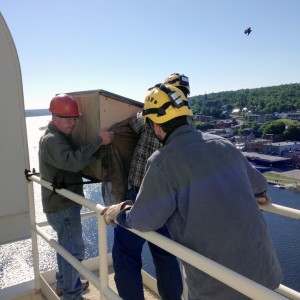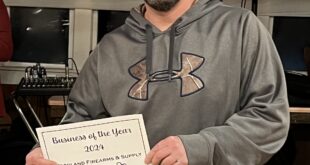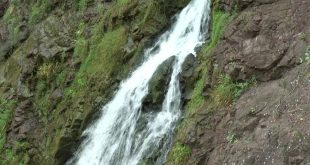The Michigan Department of Transportation (MDOT) installed two nest boxes – one each on the north and south bridge towers – in spring 2012 and a pair of peregrine falcons showed up the next spring.
After raising four chicks on the south tower last year, the pair produced three offspring in a nest on the north tower this year. The chicks were banded by a Michigan Department of Natural Resources (MDNR) team on June 23.
“The birds appeared to be a little more than four weeks old,” MDNR Wildlife Technician Brad Johnson said. “We banded one male and two female birds.”
Johnson said the banding went smoothly, despite a lot of recent activity at the bridge, including last weekend’s Bridgefest and ongoing construction activity.
MDOT took precautions to shield the nesting boxes from construction work – part of the $8.4 million upgrade and preventive maintenance project running through April 2016. Screens were placed to keep the falcons from seeing workers in the bridge machinery rooms and efforts were made to minimize disturbances in the nest area.
The new peregrines – Butch, Lisa and Carla – were named by bridge workers and should be ready to leave the nest in another two to three weeks.
The peregrine falcon has been removed from the federal endangered species list, but is listed as an endangered species in Michigan, protected by state and federal law. Peregrines have adapted to city habitats, nesting on tall buildings, smokestacks and bridges around the world. Studies have found the birds in this region tend not to nest in the same area where they were hatched, but spread out across the Midwest.
MDOT has also placed falcon boxes on the Sault Ste. Marie International Bridge and the Mackinac Bridge.
Every nesting site is special – there are only 46 nest sites in the entire state, with 38 of them on artificial structures. Most of the natural sites are inaccessible for banding birds, so having boxes on an accessible structure like the Lift Bridge helps the MDNR follow the raptor’s comeback. Color-coded bands are attached to the legs of young birds so that scientists can track the dispersal, migration, life span, reproductive success, behavior, and population growth of the falcons.
High-speed hunters capable of flying at 200 mph, the peregrines help keep populations of nuisance pigeons under control. Biologists said the peregrines at the Houghton-Hancock Lift Bridge appear to be preying on a fair number of pigeons. Keeping pigeon numbers under control may save MODT some maintenance money down the line, as pigeon droppings can damage paint on metal bridge surfaces.
 Keweenaw Report Your Source for Local News and Sports
Keweenaw Report Your Source for Local News and Sports





